Racism, Intersectionality, and Social Work: A Critical Analysis
VerifiedAdded on 2023/03/21
|8
|2135
|80
Essay
AI Summary
This essay delves into the contemporary issue of racism, exploring its manifestations in various settings such as workplaces, courts, and educational institutions. It examines the concept of racism through its historical origins, institutional practices, and power imbalances, highlighting how these factors contribute to its perpetuation. The essay also presents a personal viewpoint on the tensions inherent in understanding racism, particularly regarding the role of historical awareness. Connecting these perspectives to intersectionality theory, the analysis reveals the interplay between racial discrimination and gender inequality, illustrating how these forms of oppression intersect and reinforce each other. The essay concludes by emphasizing the importance of minimizing and eliminating racism to foster a harmonious and equitable society, suggesting that a deeper understanding of its roots and dynamics is crucial for achieving this goal. Desklib provides access to similar essays and study tools for students.
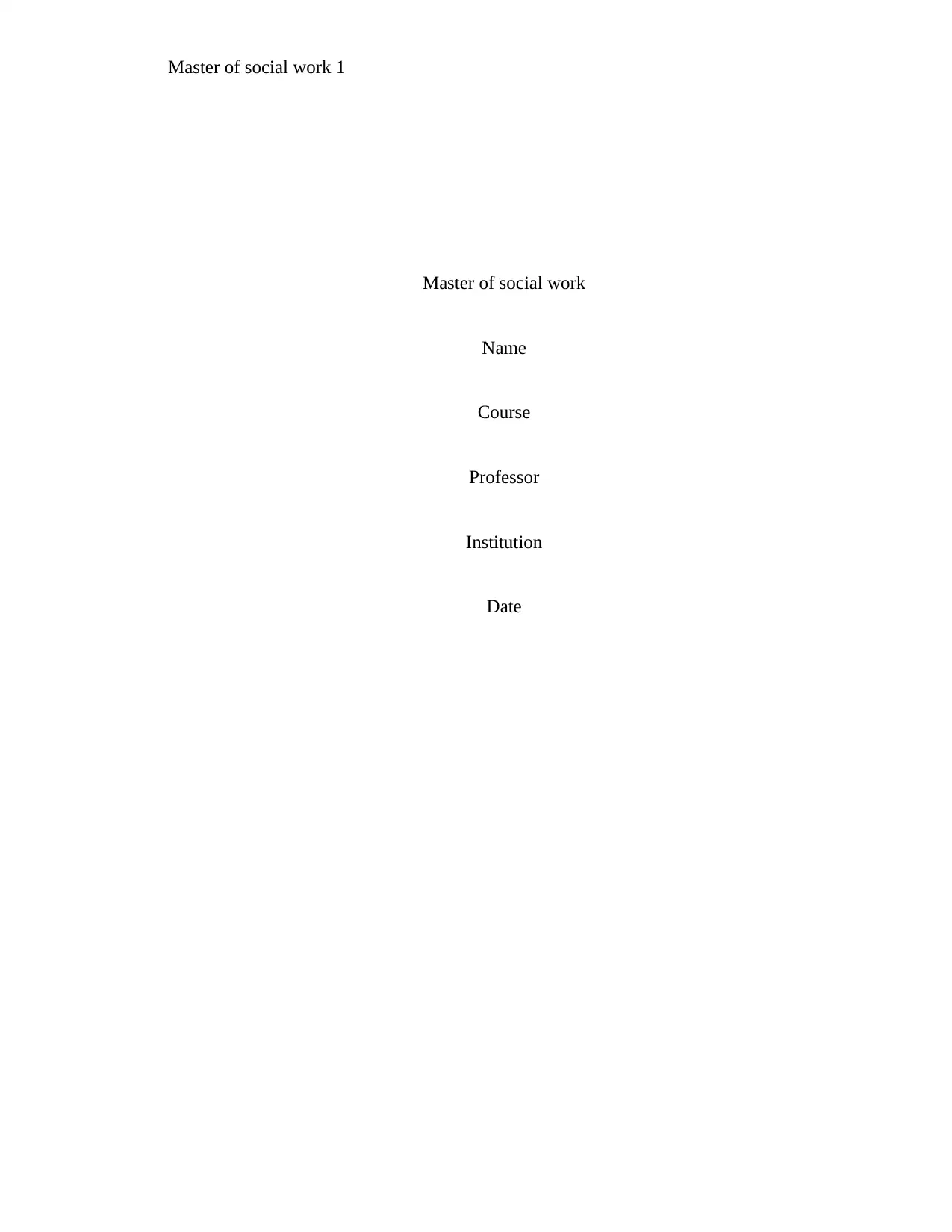
Master of social work 1
Master of social work
Name
Course
Professor
Institution
Date
Master of social work
Name
Course
Professor
Institution
Date
Paraphrase This Document
Need a fresh take? Get an instant paraphrase of this document with our AI Paraphraser
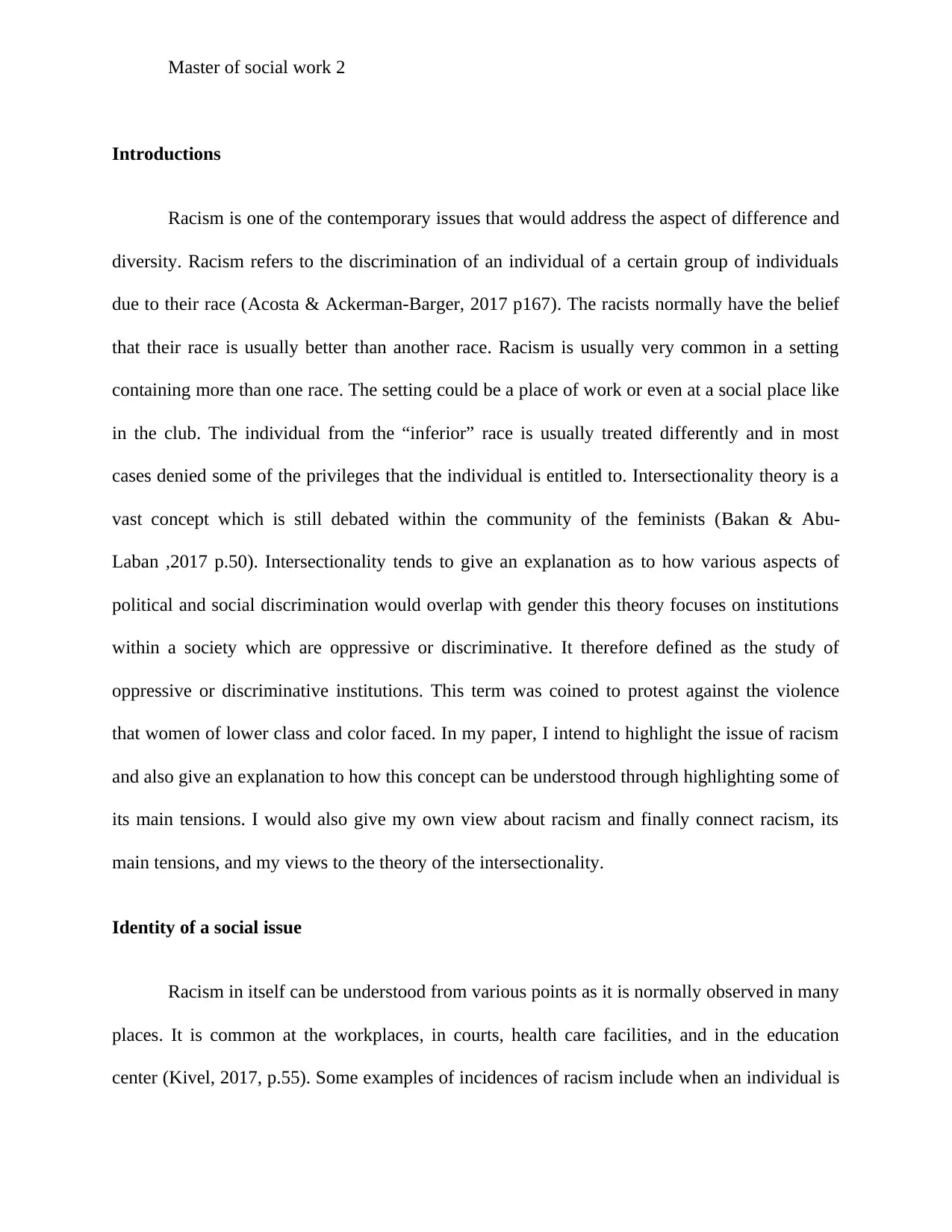
Master of social work 2
Introductions
Racism is one of the contemporary issues that would address the aspect of difference and
diversity. Racism refers to the discrimination of an individual of a certain group of individuals
due to their race (Acosta & Ackerman-Barger, 2017 p167). The racists normally have the belief
that their race is usually better than another race. Racism is usually very common in a setting
containing more than one race. The setting could be a place of work or even at a social place like
in the club. The individual from the “inferior” race is usually treated differently and in most
cases denied some of the privileges that the individual is entitled to. Intersectionality theory is a
vast concept which is still debated within the community of the feminists (Bakan & Abu-
Laban ,2017 p.50). Intersectionality tends to give an explanation as to how various aspects of
political and social discrimination would overlap with gender this theory focuses on institutions
within a society which are oppressive or discriminative. It therefore defined as the study of
oppressive or discriminative institutions. This term was coined to protest against the violence
that women of lower class and color faced. In my paper, I intend to highlight the issue of racism
and also give an explanation to how this concept can be understood through highlighting some of
its main tensions. I would also give my own view about racism and finally connect racism, its
main tensions, and my views to the theory of the intersectionality.
Identity of a social issue
Racism in itself can be understood from various points as it is normally observed in many
places. It is common at the workplaces, in courts, health care facilities, and in the education
center (Kivel, 2017, p.55). Some examples of incidences of racism include when an individual is
Introductions
Racism is one of the contemporary issues that would address the aspect of difference and
diversity. Racism refers to the discrimination of an individual of a certain group of individuals
due to their race (Acosta & Ackerman-Barger, 2017 p167). The racists normally have the belief
that their race is usually better than another race. Racism is usually very common in a setting
containing more than one race. The setting could be a place of work or even at a social place like
in the club. The individual from the “inferior” race is usually treated differently and in most
cases denied some of the privileges that the individual is entitled to. Intersectionality theory is a
vast concept which is still debated within the community of the feminists (Bakan & Abu-
Laban ,2017 p.50). Intersectionality tends to give an explanation as to how various aspects of
political and social discrimination would overlap with gender this theory focuses on institutions
within a society which are oppressive or discriminative. It therefore defined as the study of
oppressive or discriminative institutions. This term was coined to protest against the violence
that women of lower class and color faced. In my paper, I intend to highlight the issue of racism
and also give an explanation to how this concept can be understood through highlighting some of
its main tensions. I would also give my own view about racism and finally connect racism, its
main tensions, and my views to the theory of the intersectionality.
Identity of a social issue
Racism in itself can be understood from various points as it is normally observed in many
places. It is common at the workplaces, in courts, health care facilities, and in the education
center (Kivel, 2017, p.55). Some examples of incidences of racism include when an individual is
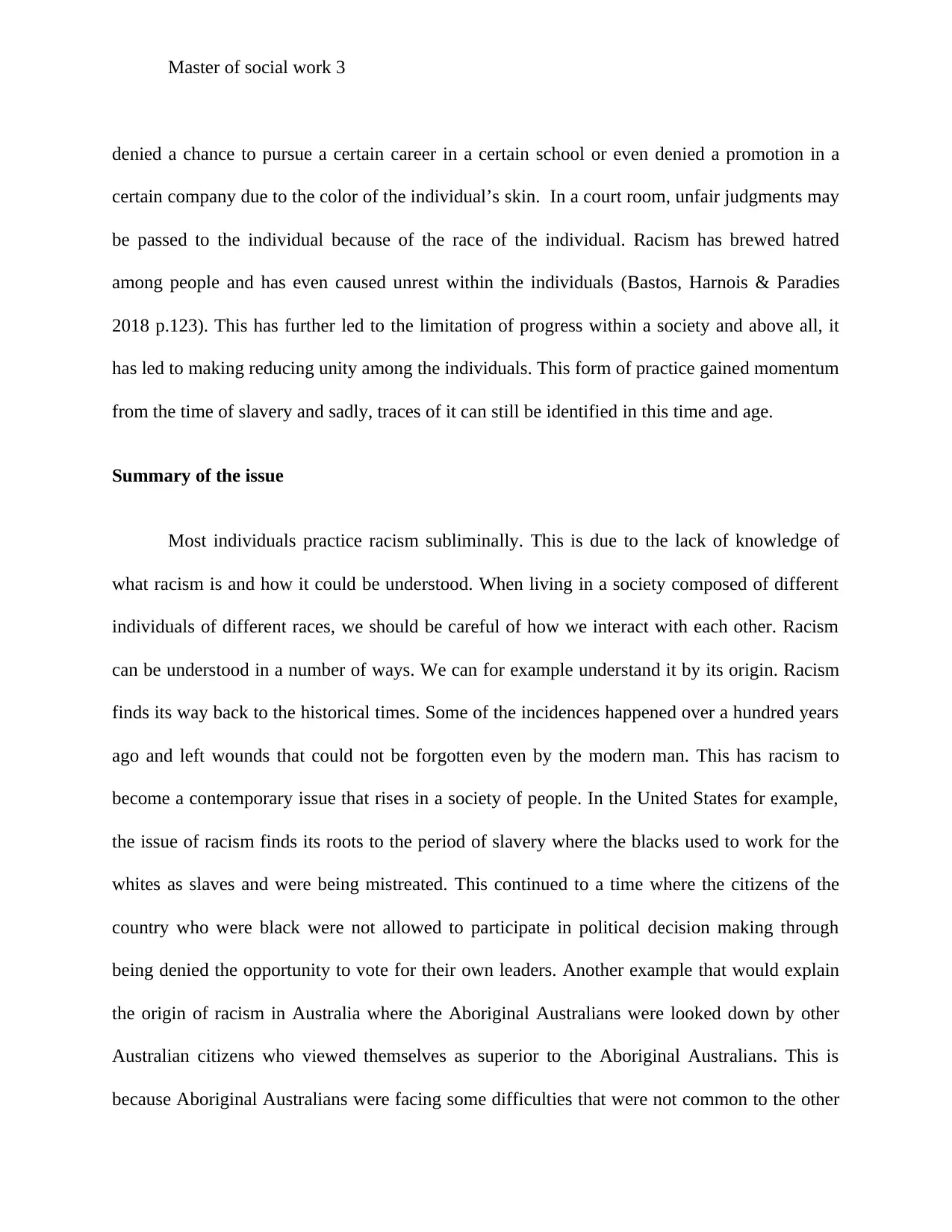
Master of social work 3
denied a chance to pursue a certain career in a certain school or even denied a promotion in a
certain company due to the color of the individual’s skin. In a court room, unfair judgments may
be passed to the individual because of the race of the individual. Racism has brewed hatred
among people and has even caused unrest within the individuals (Bastos, Harnois & Paradies
2018 p.123). This has further led to the limitation of progress within a society and above all, it
has led to making reducing unity among the individuals. This form of practice gained momentum
from the time of slavery and sadly, traces of it can still be identified in this time and age.
Summary of the issue
Most individuals practice racism subliminally. This is due to the lack of knowledge of
what racism is and how it could be understood. When living in a society composed of different
individuals of different races, we should be careful of how we interact with each other. Racism
can be understood in a number of ways. We can for example understand it by its origin. Racism
finds its way back to the historical times. Some of the incidences happened over a hundred years
ago and left wounds that could not be forgotten even by the modern man. This has racism to
become a contemporary issue that rises in a society of people. In the United States for example,
the issue of racism finds its roots to the period of slavery where the blacks used to work for the
whites as slaves and were being mistreated. This continued to a time where the citizens of the
country who were black were not allowed to participate in political decision making through
being denied the opportunity to vote for their own leaders. Another example that would explain
the origin of racism in Australia where the Aboriginal Australians were looked down by other
Australian citizens who viewed themselves as superior to the Aboriginal Australians. This is
because Aboriginal Australians were facing some difficulties that were not common to the other
denied a chance to pursue a certain career in a certain school or even denied a promotion in a
certain company due to the color of the individual’s skin. In a court room, unfair judgments may
be passed to the individual because of the race of the individual. Racism has brewed hatred
among people and has even caused unrest within the individuals (Bastos, Harnois & Paradies
2018 p.123). This has further led to the limitation of progress within a society and above all, it
has led to making reducing unity among the individuals. This form of practice gained momentum
from the time of slavery and sadly, traces of it can still be identified in this time and age.
Summary of the issue
Most individuals practice racism subliminally. This is due to the lack of knowledge of
what racism is and how it could be understood. When living in a society composed of different
individuals of different races, we should be careful of how we interact with each other. Racism
can be understood in a number of ways. We can for example understand it by its origin. Racism
finds its way back to the historical times. Some of the incidences happened over a hundred years
ago and left wounds that could not be forgotten even by the modern man. This has racism to
become a contemporary issue that rises in a society of people. In the United States for example,
the issue of racism finds its roots to the period of slavery where the blacks used to work for the
whites as slaves and were being mistreated. This continued to a time where the citizens of the
country who were black were not allowed to participate in political decision making through
being denied the opportunity to vote for their own leaders. Another example that would explain
the origin of racism in Australia where the Aboriginal Australians were looked down by other
Australian citizens who viewed themselves as superior to the Aboriginal Australians. This is
because Aboriginal Australians were facing some difficulties that were not common to the other
⊘ This is a preview!⊘
Do you want full access?
Subscribe today to unlock all pages.

Trusted by 1+ million students worldwide

Master of social work 4
Australians. Some of the difficulties included, a short life expectancy, lower employment rates
and also higher chances of committing suicide. This made the Aboriginal Australians feel
marginalized and generations after generation lived to remember such mistreatment and
marginalization (Gillborn 2015, p.280). This made the concept of racism to grow deeper roots as
ever generation carried with them the hurt and humiliation that they faced as a community.
Another way of understanding racism is through the observing the activities of various
institutions. In the current world, the institutions are one of the major ways in which racism is
practiced and the concept is spread. Some of the major institutions where racism is perpetuated
include the organizations like the churches, schools and the court of law. This is because these
institutions tend to serve a variety of people and this does ton exempt the possibility of the
institutions serving people of different races. Chances of racism occurring are therefore very
high as some of the individuals who head the institutions might be tempted to discriminate others
based on their races (Schaffner, MacWilliams & Nteta ,2018 p.43). Institutions have also aided
deeply in shaping the policies of racism in a number of ways. For examples, policies of racism
are shaped through occurrences like the increased deaths of the Aboriginal Australians in the
custody of the police. Another example is the arrest and killing of the black youth by the police
before even undergoing a fair trial. Unexplained firing of Abnormal Australians citizens form
companies is also another way as to how institutions have contributed to the promotion of racism
within the society.
Another way in which racism could be understood is by looking power imbalance based
on the race. This would give an explanation as to why some of the words considered as racist
when used by a particular race to another while when the same words are used by amongst the
Australians. Some of the difficulties included, a short life expectancy, lower employment rates
and also higher chances of committing suicide. This made the Aboriginal Australians feel
marginalized and generations after generation lived to remember such mistreatment and
marginalization (Gillborn 2015, p.280). This made the concept of racism to grow deeper roots as
ever generation carried with them the hurt and humiliation that they faced as a community.
Another way of understanding racism is through the observing the activities of various
institutions. In the current world, the institutions are one of the major ways in which racism is
practiced and the concept is spread. Some of the major institutions where racism is perpetuated
include the organizations like the churches, schools and the court of law. This is because these
institutions tend to serve a variety of people and this does ton exempt the possibility of the
institutions serving people of different races. Chances of racism occurring are therefore very
high as some of the individuals who head the institutions might be tempted to discriminate others
based on their races (Schaffner, MacWilliams & Nteta ,2018 p.43). Institutions have also aided
deeply in shaping the policies of racism in a number of ways. For examples, policies of racism
are shaped through occurrences like the increased deaths of the Aboriginal Australians in the
custody of the police. Another example is the arrest and killing of the black youth by the police
before even undergoing a fair trial. Unexplained firing of Abnormal Australians citizens form
companies is also another way as to how institutions have contributed to the promotion of racism
within the society.
Another way in which racism could be understood is by looking power imbalance based
on the race. This would give an explanation as to why some of the words considered as racist
when used by a particular race to another while when the same words are used by amongst the
Paraphrase This Document
Need a fresh take? Get an instant paraphrase of this document with our AI Paraphraser
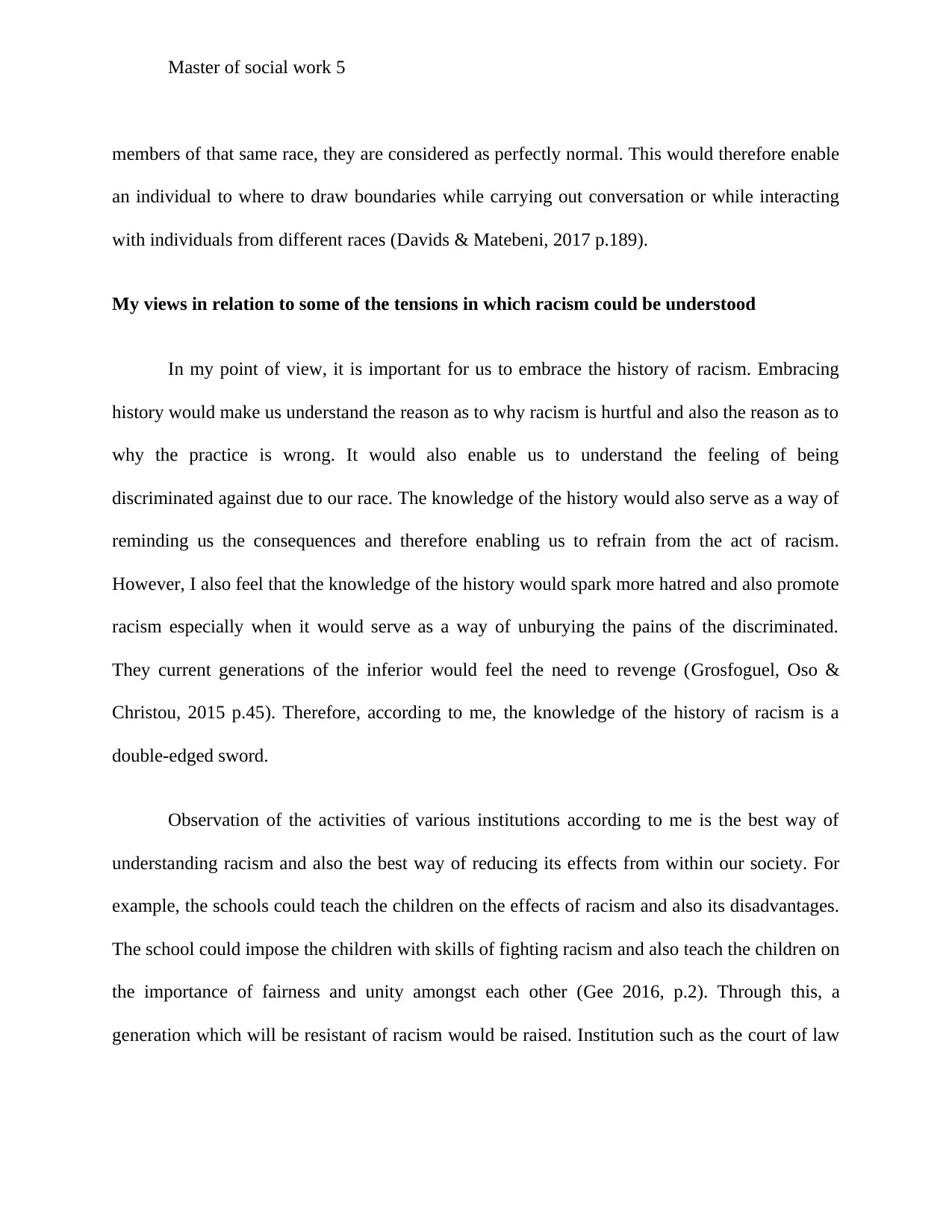
Master of social work 5
members of that same race, they are considered as perfectly normal. This would therefore enable
an individual to where to draw boundaries while carrying out conversation or while interacting
with individuals from different races (Davids & Matebeni, 2017 p.189).
My views in relation to some of the tensions in which racism could be understood
In my point of view, it is important for us to embrace the history of racism. Embracing
history would make us understand the reason as to why racism is hurtful and also the reason as to
why the practice is wrong. It would also enable us to understand the feeling of being
discriminated against due to our race. The knowledge of the history would also serve as a way of
reminding us the consequences and therefore enabling us to refrain from the act of racism.
However, I also feel that the knowledge of the history would spark more hatred and also promote
racism especially when it would serve as a way of unburying the pains of the discriminated.
They current generations of the inferior would feel the need to revenge (Grosfoguel, Oso &
Christou, 2015 p.45). Therefore, according to me, the knowledge of the history of racism is a
double-edged sword.
Observation of the activities of various institutions according to me is the best way of
understanding racism and also the best way of reducing its effects from within our society. For
example, the schools could teach the children on the effects of racism and also its disadvantages.
The school could impose the children with skills of fighting racism and also teach the children on
the importance of fairness and unity amongst each other (Gee 2016, p.2). Through this, a
generation which will be resistant of racism would be raised. Institution such as the court of law
members of that same race, they are considered as perfectly normal. This would therefore enable
an individual to where to draw boundaries while carrying out conversation or while interacting
with individuals from different races (Davids & Matebeni, 2017 p.189).
My views in relation to some of the tensions in which racism could be understood
In my point of view, it is important for us to embrace the history of racism. Embracing
history would make us understand the reason as to why racism is hurtful and also the reason as to
why the practice is wrong. It would also enable us to understand the feeling of being
discriminated against due to our race. The knowledge of the history would also serve as a way of
reminding us the consequences and therefore enabling us to refrain from the act of racism.
However, I also feel that the knowledge of the history would spark more hatred and also promote
racism especially when it would serve as a way of unburying the pains of the discriminated.
They current generations of the inferior would feel the need to revenge (Grosfoguel, Oso &
Christou, 2015 p.45). Therefore, according to me, the knowledge of the history of racism is a
double-edged sword.
Observation of the activities of various institutions according to me is the best way of
understanding racism and also the best way of reducing its effects from within our society. For
example, the schools could teach the children on the effects of racism and also its disadvantages.
The school could impose the children with skills of fighting racism and also teach the children on
the importance of fairness and unity amongst each other (Gee 2016, p.2). Through this, a
generation which will be resistant of racism would be raised. Institution such as the court of law

Master of social work 6
could also aid in eliminating racism through the ensuring that fair judgments are passed despite
the race of an individual.
Connection between the theory of intersectionality, racism, tensions of understanding
racism and my position to the tensions of understanding racism
The theory of intersectionality is connected to racism in that the there is a connection
between racial discrimination and gender inequality. This therefore explains the fact that an
individual who is discriminated due to gender is also likely to face discrimination due to the race
of the individual (Collins & Bilge, 2016p.54). Intersectionality of the inequality of the gender
can also be used to explain the origin of racism. For instance, one could conclude that black
males were preferred by the whites as slaves for they had the strengths to perform difficult tasks
such as ploughing a large piece of the farm. In India also, the source oppression is usually caste
based. Caste in Indian is normally based on their religious system. For example, women from
poorer families find it difficult for them to marry or even get into relationships due to their
inability to raise dowry. In most third world countries however race is normally the source of
oppression (Lewis & Grzanka 2016 p.76). I can also connect the theory of intersectionality to
the view of acknowledging roots of racism. The theories would enable us understand other races
better making us to become tolerant to one another therefore acting as a tool of reducing racism
within ourselves (Pugach, Gomez-Najarro & Matewos 2018 p.78).
Conclusion
Racism is oppression against the humans and therefore it is very important to minimize or
even eliminate it so as to ensure that we live in harmony within the society.
could also aid in eliminating racism through the ensuring that fair judgments are passed despite
the race of an individual.
Connection between the theory of intersectionality, racism, tensions of understanding
racism and my position to the tensions of understanding racism
The theory of intersectionality is connected to racism in that the there is a connection
between racial discrimination and gender inequality. This therefore explains the fact that an
individual who is discriminated due to gender is also likely to face discrimination due to the race
of the individual (Collins & Bilge, 2016p.54). Intersectionality of the inequality of the gender
can also be used to explain the origin of racism. For instance, one could conclude that black
males were preferred by the whites as slaves for they had the strengths to perform difficult tasks
such as ploughing a large piece of the farm. In India also, the source oppression is usually caste
based. Caste in Indian is normally based on their religious system. For example, women from
poorer families find it difficult for them to marry or even get into relationships due to their
inability to raise dowry. In most third world countries however race is normally the source of
oppression (Lewis & Grzanka 2016 p.76). I can also connect the theory of intersectionality to
the view of acknowledging roots of racism. The theories would enable us understand other races
better making us to become tolerant to one another therefore acting as a tool of reducing racism
within ourselves (Pugach, Gomez-Najarro & Matewos 2018 p.78).
Conclusion
Racism is oppression against the humans and therefore it is very important to minimize or
even eliminate it so as to ensure that we live in harmony within the society.
⊘ This is a preview!⊘
Do you want full access?
Subscribe today to unlock all pages.

Trusted by 1+ million students worldwide
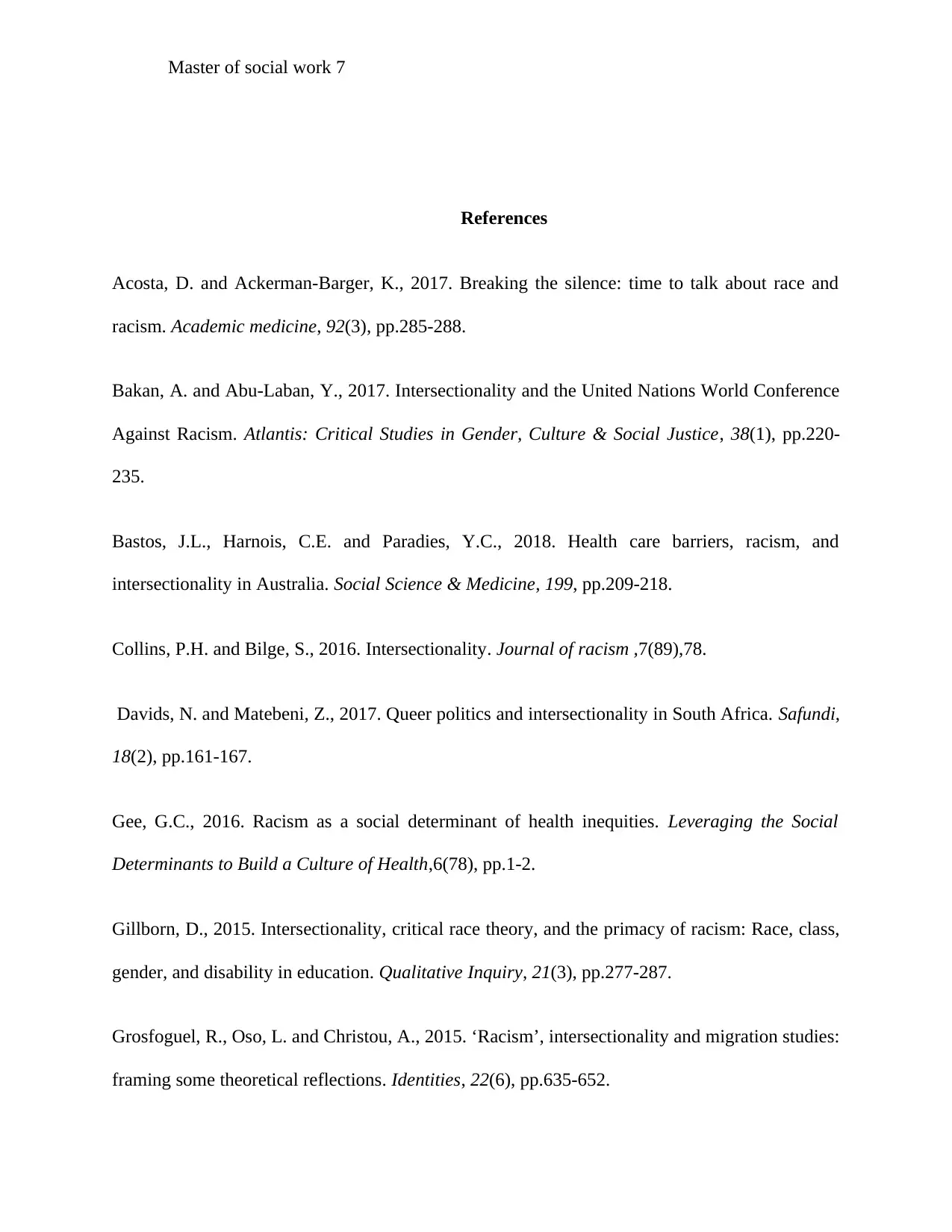
Master of social work 7
References
Acosta, D. and Ackerman-Barger, K., 2017. Breaking the silence: time to talk about race and
racism. Academic medicine, 92(3), pp.285-288.
Bakan, A. and Abu-Laban, Y., 2017. Intersectionality and the United Nations World Conference
Against Racism. Atlantis: Critical Studies in Gender, Culture & Social Justice, 38(1), pp.220-
235.
Bastos, J.L., Harnois, C.E. and Paradies, Y.C., 2018. Health care barriers, racism, and
intersectionality in Australia. Social Science & Medicine, 199, pp.209-218.
Collins, P.H. and Bilge, S., 2016. Intersectionality. Journal of racism ,7(89),78.
Davids, N. and Matebeni, Z., 2017. Queer politics and intersectionality in South Africa. Safundi,
18(2), pp.161-167.
Gee, G.C., 2016. Racism as a social determinant of health inequities. Leveraging the Social
Determinants to Build a Culture of Health,6(78), pp.1-2.
Gillborn, D., 2015. Intersectionality, critical race theory, and the primacy of racism: Race, class,
gender, and disability in education. Qualitative Inquiry, 21(3), pp.277-287.
Grosfoguel, R., Oso, L. and Christou, A., 2015. ‘Racism’, intersectionality and migration studies:
framing some theoretical reflections. Identities, 22(6), pp.635-652.
References
Acosta, D. and Ackerman-Barger, K., 2017. Breaking the silence: time to talk about race and
racism. Academic medicine, 92(3), pp.285-288.
Bakan, A. and Abu-Laban, Y., 2017. Intersectionality and the United Nations World Conference
Against Racism. Atlantis: Critical Studies in Gender, Culture & Social Justice, 38(1), pp.220-
235.
Bastos, J.L., Harnois, C.E. and Paradies, Y.C., 2018. Health care barriers, racism, and
intersectionality in Australia. Social Science & Medicine, 199, pp.209-218.
Collins, P.H. and Bilge, S., 2016. Intersectionality. Journal of racism ,7(89),78.
Davids, N. and Matebeni, Z., 2017. Queer politics and intersectionality in South Africa. Safundi,
18(2), pp.161-167.
Gee, G.C., 2016. Racism as a social determinant of health inequities. Leveraging the Social
Determinants to Build a Culture of Health,6(78), pp.1-2.
Gillborn, D., 2015. Intersectionality, critical race theory, and the primacy of racism: Race, class,
gender, and disability in education. Qualitative Inquiry, 21(3), pp.277-287.
Grosfoguel, R., Oso, L. and Christou, A., 2015. ‘Racism’, intersectionality and migration studies:
framing some theoretical reflections. Identities, 22(6), pp.635-652.
Paraphrase This Document
Need a fresh take? Get an instant paraphrase of this document with our AI Paraphraser
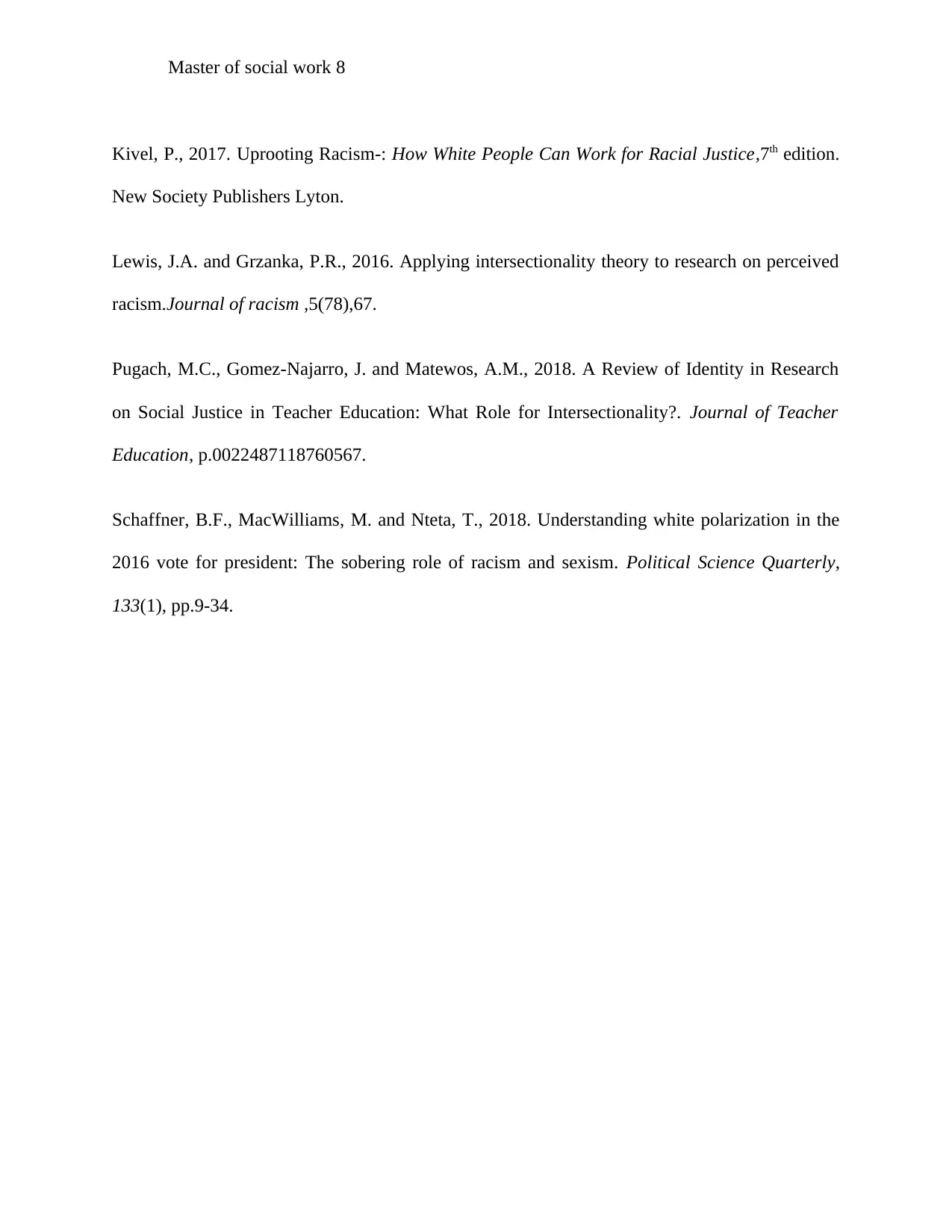
Master of social work 8
Kivel, P., 2017. Uprooting Racism-: How White People Can Work for Racial Justice,7th edition.
New Society Publishers Lyton.
Lewis, J.A. and Grzanka, P.R., 2016. Applying intersectionality theory to research on perceived
racism.Journal of racism ,5(78),67.
Pugach, M.C., Gomez-Najarro, J. and Matewos, A.M., 2018. A Review of Identity in Research
on Social Justice in Teacher Education: What Role for Intersectionality?. Journal of Teacher
Education, p.0022487118760567.
Schaffner, B.F., MacWilliams, M. and Nteta, T., 2018. Understanding white polarization in the
2016 vote for president: The sobering role of racism and sexism. Political Science Quarterly,
133(1), pp.9-34.
Kivel, P., 2017. Uprooting Racism-: How White People Can Work for Racial Justice,7th edition.
New Society Publishers Lyton.
Lewis, J.A. and Grzanka, P.R., 2016. Applying intersectionality theory to research on perceived
racism.Journal of racism ,5(78),67.
Pugach, M.C., Gomez-Najarro, J. and Matewos, A.M., 2018. A Review of Identity in Research
on Social Justice in Teacher Education: What Role for Intersectionality?. Journal of Teacher
Education, p.0022487118760567.
Schaffner, B.F., MacWilliams, M. and Nteta, T., 2018. Understanding white polarization in the
2016 vote for president: The sobering role of racism and sexism. Political Science Quarterly,
133(1), pp.9-34.
1 out of 8
Related Documents
Your All-in-One AI-Powered Toolkit for Academic Success.
+13062052269
info@desklib.com
Available 24*7 on WhatsApp / Email
![[object Object]](/_next/static/media/star-bottom.7253800d.svg)
Unlock your academic potential
Copyright © 2020–2025 A2Z Services. All Rights Reserved. Developed and managed by ZUCOL.





